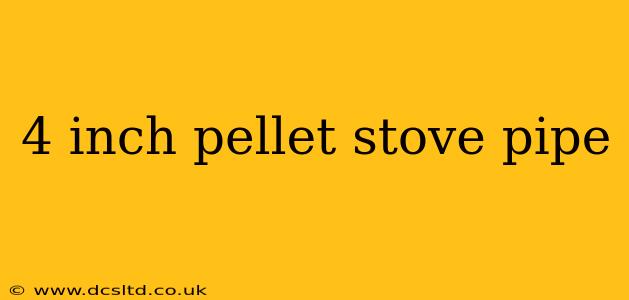4-Inch Pellet Stove Pipe: A Comprehensive Guide
Choosing the right pellet stove pipe is crucial for safe and efficient operation of your heating system. A 4-inch diameter pipe is a common size, but understanding its implications for your setup is key. This guide will explore everything you need to know about 4-inch pellet stove pipe, addressing common questions and concerns.
What are the advantages of using 4-inch pellet stove pipe?
The choice of 4-inch pipe often comes down to the stove's output and the desired draft. A 4-inch diameter offers a good balance between efficient exhaust and manageable installation. Larger diameters might offer slightly better draft, but they can also be more expensive and cumbersome to install. Smaller diameters, on the other hand, can restrict airflow and lead to inefficient operation or even dangerous backdrafting. Ultimately, the ideal diameter depends on the stove manufacturer's specifications. Always consult your stove's manual for the recommended pipe size.
What are the disadvantages of using 4-inch pellet stove pipe?
While generally suitable, 4-inch pipe might present some limitations. If your stove requires a higher exhaust flow rate than what a 4-inch pipe can efficiently handle, you may experience incomplete combustion, leading to reduced heating efficiency and potential creosote buildup. This buildup can pose a serious fire hazard. Similarly, if your installation involves a long run of pipe or multiple bends, the restricted airflow could negatively impact performance.
What type of 4-inch pellet stove pipe is best?
Pellet stove pipe is typically made of single-wall or double-wall stainless steel. Double-wall pipe is strongly recommended for safety reasons. It features an air gap between the inner and outer walls, preventing the outer wall from getting excessively hot and reducing the risk of ignition. Single-wall pipe is generally less expensive but poses a higher fire risk and is often only suitable for short, well-ventilated runs – check local codes before installation.
How long can a 4-inch pellet stove pipe run be?
The maximum length of your pellet stove pipe depends on several factors, including the stove's output, the number of elbows or bends in the pipe, and the overall height of the chimney. Excessive length can restrict airflow, reducing efficiency and increasing the risk of creosote buildup. Always refer to your stove's manual and local building codes for specific recommendations. Consult a professional installer if you have any doubts.
How many elbows can I use in a 4-inch pellet stove pipe run?
Each elbow in your pipe run increases the resistance to airflow. Too many elbows can significantly restrict the draft, leading to poor performance and potential safety hazards. The maximum number of elbows allowed will be specified in your stove’s installation instructions and local building codes. Minimizing the number of elbows by carefully planning the pipe route is crucial for optimal performance.
What are the building codes and safety regulations for 4-inch pellet stove pipe installations?
Installation of pellet stove piping must comply with local building codes and relevant safety standards. These regulations usually address aspects such as pipe clearance from combustible materials, proper venting, and the use of approved pipe components. Always check with your local authority having jurisdiction (AHJ) to ensure your installation meets all requirements. Non-compliance can void warranties and create significant safety risks. A professional installation is highly recommended.
Can I use a 4-inch pipe for a stove with a larger diameter output?
No. Using a smaller diameter pipe than recommended by the stove manufacturer is extremely dangerous. It can lead to restricted airflow, incomplete combustion, increased creosote buildup, and potential fire hazards. Always use the pipe size specified in your stove's manual.
This guide provides a starting point for understanding 4-inch pellet stove pipe. Remember, safety should always be the top priority. Consult your stove's manual and seek professional help for installation if needed. Improper installation can lead to significant safety hazards, including fire.
